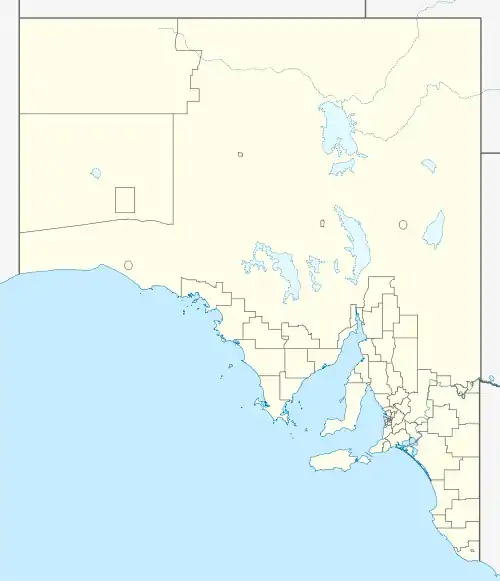Kalangadoo, South Australia
Kalangadoo (formerly Kalangadoo East) is a locality in the Australian state of South Australia located about 348 kilometres (216 mi) south-east of the state capital of Adelaide and about 31 kilometres (19 mi) north of the regional centre of Mount Gambier.[1][4]
| Kalangadoo South Australia | |||||||||||||||
|---|---|---|---|---|---|---|---|---|---|---|---|---|---|---|---|
 Kalangadoo Hotel | |||||||||||||||
 Kalangadoo | |||||||||||||||
| Coordinates | 37°33′S 140°42′E[1] | ||||||||||||||
| Population | 305 (2006 census)[2] | ||||||||||||||
| Established | 1891 (town) 13 December 2001 (locality)[1][3] | ||||||||||||||
| Postcode(s) | 5278[4] | ||||||||||||||
| Time zone | ACST (UTC+9:30) | ||||||||||||||
| • Summer (DST) | ACDT (UTC+10:30) | ||||||||||||||
| Location |
| ||||||||||||||
| LGA(s) | Wattle Range Council | ||||||||||||||
| Region | Limestone Coast[5] | ||||||||||||||
| County | Grey[1] | ||||||||||||||
| State electorate(s) | MacKillop[6] | ||||||||||||||
| Federal Division(s) | Barker[7] | ||||||||||||||
| |||||||||||||||
| |||||||||||||||
| Footnotes | Adjoining localities[1] Locations[4] | ||||||||||||||
It was originally proclaimed as Kalangadoo East in 1891, and the name changed to Kalangadoo in 1940. The aboriginal word means "Big trees in water."[9][1] The town grew around the Kalangadoo railway station on the Mount Gambier railway line between Naracoorte and Mount Gambier which was opened in 1887 until it closed to freight on 12 April 1995 then tourist trains 1 July 2006.
Today the small business district includes a general store, a farm supply store, a pub, and a timber mill. The disused railway station houses a small museum. At the 2006 census, Kalangadoo had a population of 305.[2]

Kalangadoo is the centre of a rich agricultural district that specialises in potatoes and timber, as well as apple orchards, beef cattle, sheep and dairy cattle. The village flourished after the narrow gauge railroad arrived in 1887. It languished after World War II as farmers used their cars to shop in Penola and Mount Gambier.[10] The railway closed to freight on 12 April 1995 then Limestone Coast Railway tourist trains ended on 1 July 2006.
The Anglican Church of St Alban the Martyr is the only active church, as the Catholic church (built 1904) is seldom used and the Presbyterian church (opened 1914) is now a B & B. [11] The Uniting Church opened in 1906 and closed in 2007, with its old buildings used for the weekly farmers' market.[12] The public school established in 1892 reached a peak enrolment of 150 pupils in 1966, falling to 74 by 1991.[13][14]
The historic Kalangadoo House, off the Kalangadoo-Nangwarry Road, is located on the South Australian Heritage Register.[15]
Kalangadoo is located within the federal division of Barker, the state electoral district of MacKillop and the local government area of Wattle Range.
Citations and references
- Citations
- "Search result for "KALANGADOO (LOCB)" (Record no SA0033524) with the following layers being selected - "Suburbs and Localities", "Local Government Areas", "Development Plan Layers", "Place names (gazetteer)", "Counties" and "Hundreds"". Property Location Browser. Government of South Australia. Archived from the original on 12 October 2016. Retrieved 7 May 2017.
- Australian Bureau of Statistics (25 October 2007). "Kalangadoo (L) (Urban Centre/Locality)". 2006 Census QuickStats. Retrieved 2 August 2011.
- Lawson, R. (13 December 2001). "GEOGRAPHICAL NAMES ACT 1991 Notice to Assign Boundaries and Names to Places (in the Wattle Range Council)" (PDF). The South Australian Government Gazette. South Australian Government. p. 5365. Retrieved 27 February 2018.
- "Postcode for Kalangadoo, South Australia". Retrieved 7 May 2017.
- "Limestone Coast SA Government region" (PDF). The Government of South Australia. Retrieved 10 October 2014.
- "District of MacKillop Background Profile". Electoral Commission SA. Retrieved 29 March 2016.
- "Federal electoral division of Barker" (PDF). Australian Electoral Commission. Retrieved 28 March 2016.
- "Monthly climate statistics: Summary statistics Mount Gambier Aero (nearest weather station)". Commonwealth of Australia , Bureau of Meteorology. Retrieved 27 November 2018.
- Chuck, 1991, p 20
- Chuck, 1991
- Chuck, 1991, pp 186-87
- Raymond E. Pocock, Kalangadoo, the Church of Saint Alban the Martyr: a brief history (1968)
- Chuck, p 135
- Nick Hunt, Kalangadoo Primary School (1992)
- "Dwelling ('Kalangadoo House')". South Australian Heritage Register. Department of Environment, Water and Natural Resources. Retrieved 26 August 2016.
- References
- Chuck, Reg; Hawke, Marion (1991), Big trees in water : Kalangadoo, the town and the people, 1850-1990, Marion Hawke, ISBN 978-0-646-04813-0
| Wikimedia Commons has media related to Kalangadoo, South Australia. |